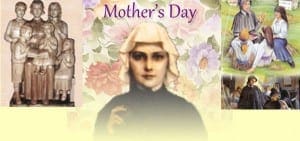 “I AM A MOTHER”: SAINT ELIZABETH ANN SETON ON MOTHERHOOD
“I AM A MOTHER”: SAINT ELIZABETH ANN SETON ON MOTHERHOOD
The letters of Saint Elizabeth Seton (1774-1821) to and about her family reflect exactly the kind of concerns a mother today would have about her children’s lives, choices, job prospects, etc. She wrote and worried about people, money, weather, difficulties and everyday happenings.
Elizabeth’s own mother died when she was only 3 years old. Her father remarried, but her stepmother was not very loving to Elizabeth and her older sister Mary during her father’s long absences. Her unhappy childhood made her want to show others the affection she never had. She later remembered how, as a girl of 12, she would “love to nurse the children and sing little hymns over the cradle.”
Happily married at 19 to William Magee Seton, she had 5 children in 7 ½ years – Anna Maria, William, Richard, Catherine, and Rebecca. She loved being a mother, and wrote proudly, “My world is my family.” She bragged to a friend about baby Catherine: “She sleeps continually and makes none of those crooked faces children of a month old generally do.”
A mother’s life is not her own. Elizabeth wrote:“My precious children stick to me like little burrs, they are so fearful of losing me again, the moment I shake one off one side another clings in the opposite, nor can I write one word without some sweet interruption.”Most mothers will recognize the feeling!
When her Seton father-in-law died in 1798, Elizabeth and her husband had to become parents for six of the younger Seton children in addition to their own brood. She wrote that her motherly heart was stretched: “For me who so dearly loves quiet and a small family to become at once the mother of six children and the head of so large a number is a very great change.”
She managed to teach the girls at home, and mused: “Girls of twelve and fourteen are much more difficult to manage than at any other time of life.” Years later, when she began her Emmitsburg schools (the nucleus of the Catholic school system), she must have smiled to remember those words.
Her method of child-rearing became her philosophy of education: “Tenderness,” she wrote to one friend, “is the language children best understand,” and to another, “When you ask too much at first you often gain nothing at last – and if the heart is lost all is lost.”
Motherhood was no bed of roses. Elizabeth knew “the seesaw of motherly love.” Often she described nursing sick children through strep throat, whooping cough, measles, and other ailments. At Richard’s birth, both mother and child almost died. While pregnant with Catherine, she suffered “pain in the back all day, and in the side at night.” Twice she experienced the helpless agony of seeing two of her own children die – Anna Maria at 17 and Rebecca at 14.
Like most mothers, she worried a lot about her children as they grew older and began to make their way in the world. “My greatest anxiety in life is my poor boys.”
William was the only one of her children to marry, but not until after her death. Never having the joy of knowing grandchildren, she wrote wistfully: “I think had it pleased God I could have been a grandmother I would have been more tied to this life by a 2nd generation than a first.”
As a mother, Elizabeth found comfort and strength in prayer to Mary, the mother of Jesus. She had a strong sense that “God would surely refuse nothing to his Mother.”
Without a doubt, Elizabeth Seton was first and always a mother. As she tried to discern where God was leading her, her vocation of motherhood remained the center of her life: “The only word I have to say to every question is: I am a mother. Whatever providence awaits me consistent with that plea, I say Amen to it.”
“Motherhood is a place where she met her grace in a most fulfilling way,”says Sr. Judith Metz, SC. That special vocation taught Elizabeth Seton to “love, instruct, and provide for the happiness of all,” no matter how diverse (or difficult) her charges. To her community of Sisters of Charity down through the ages, she left her maternal legacy of self-giving love and belief in the healing power of loving relationships.
The realization that each person’s journey to God is necessarily made in company with others often comes more easily to women. Women’s bodies coexist for nine months with another life; they know that everything creative, including salvation, has to be a cooperative venture.
Yet the call to give oneself in love is by no means restricted to women. In her 1994 book, Sacred Dwelling: a Spirituality of Family Life, spiritual writer Wendy Wright reminds us that all of us, men and women alike, are called to bring forth life in others, just as mothers do: “We are called to be food and drink for one another, to give life, to share the substance of who we are, to have our deepest resources tapped so that the whole community can begin to realize something of the fullness of life that Jesus holds out as hope…”
Practice: Reflect on the people in your life who have showed you a mother’s love. Whether they are still living or have died, find a way to tell them how grateful you are, and to offer a prayer of thanksgiving for their presence in your life.
Regina Bechtle, SC, Charism Resource Director, Sisters of Charity of New York







0 Comments